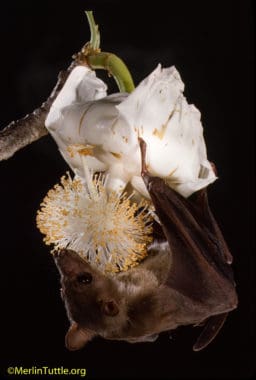Bat Flash: Countering Misinformation and Championing Evidence-Based Science
On March 6, 2024, the Wall Street Journal presented findings from the University of Leeds in their opinion piece, “Why Scientists Love Chasing Bats; The
Lena Sun’s article, “On a Bat’s Wing and a Prayer,” in the December 13, 2018 edition of The Washington Post, though well intended, contains misinformation that can threaten both conservation and public health. It leads with two false premises: bats are “some of the most dangerous animals in the world” and the rare Marburg virus is an important threat to world health. (1)
This basic discovery was covered by several news media, each with a slightly different slant. We responded to this one because it contained the worst misrepresentations. It was the only one seen that claimed bats to be “some of the most dangerous animals in the world” in addition to exaggerating the seriousness of its threat to world health.
Since its discovery in 1967, Marburg virus has caused a dozen outbreaks, killing fewer than 400 people. All the so-called “emerging diseases” speculated to be associated with bats worldwide, have killed fewer than 20,000 people in the past 40 years.
By comparison, HIV from chimpanzees has killed more than 39 million people, (2) yet these more popular animals consistently escape being labeled as dangerous. Among other viral killers in Africa, the World Health Organization reports more than 70,000 children die annually from vaccine-preventable roto virus infections. (3) It also warns of geometric growth in obesity, that according to the National Institutes of Health causes 300,000 preventable deaths annually in the U.S. alone. (4) And by extremely conservative estimate, the U.S. Centers for Disease Control and Prevention reports more than 23,000 Americans die annually from antibiotic-resistant bacterial infections. (5)
So why are we focusing limited public health resources disproportionately on the rarest threats? And why are rare risks from bats often exaggerated? The answers are simple. Bats are little known, widely feared, easy to sample, and have few defenders. Also, new viruses can be found wherever we look. These combined facts make bats uniquely vulnerable to a seemingly perfect storm. Speculation linking them to equally little known, but scary viruses has proven extremely lucrative in gaining unprecedentedly large grants and media readership, while diverting limited public health funds from far higher priorities. (6) (7)
Historically, bats have one of our planet’s finest track records of living safely with humans. Millions live in cities from America to Africa, Asia, and Australia, and have not caused even one of the world’s great pandemics. Diseases associated with bats are easily avoidable, mostly by simply not handling them. (7) Until more is known about Marburg, African caves where the virus may exist should be avoided.
For those visiting Africa, risks from mosquito-transmitted malaria or dog-transmitted rabies are orders of magnitude higher than those from any of the so-called “emerging,” but ancient, diseases speculated to be associated with bats. Our real fears should focus on preventing further loss of these already alarmingly declining, but ecologically and economically essential animals.(7)
Our combined voices can make a difference. Choose any or all means of contact to reach out to The Washington Post editors and author to politely share your opinion in your own words. Editors do take notice. Remember, your response can be very simple such as, “I don’t appreciate exaggerated speculation that creates needless fear of bats.” Editors just need to know you like or dislike an article in order for you to have impact. It’s numbers that count. Bats need all of you!

References
Love our content? Support us by sharing it!
On March 6, 2024, the Wall Street Journal presented findings from the University of Leeds in their opinion piece, “Why Scientists Love Chasing Bats; The
Response to Misleading Scientific American Bat Story I am responding to the article titled, “A Secret Weapon in Preventing the Next Pandemic: Fruit Bats,” which
Believe it or not, bats have one of our planet’s finest records of living safely with humans. Despite frequent claims to the contrary, they harbor
The series Curious Kids, hosted by The Conversation, is designed to provide expert answers to questions asked by children from around the world. The December
2024 © Merlin Tuttle’s Bat Conservation. All rights reserved.
Madelline Mathis has a degree in environmental studies from Rollins College and a passion for wildlife conservation. She is an outstanding nature photographer who has worked extensively with Merlin and other MTBC staff studying and photographing bats in Mozambique, Cuba, Costa Rica, and Texas. Following college graduation, she was employed as an environmental specialist for the Florida Department of Environmental Protection. She subsequently founded the Florida chapter of the International DarkSky Association and currently serves on the board of DarkSky Texas. She also serves on the board of Houston Wilderness and was appointed to the Austin Water Resource Community Planning Task Force.
Michael Lazari Karapetian has over twenty years of investment management experience. He has a degree in business management, is a certified NBA agent, and gained early experience as a money manager for the Bank of America where he established model portfolios for high-net-worth clients. In 2003 he founded Lazari Capital Management, Inc. and Lazari Asset Management, Inc. He is President and CIO of both and manages over a half a billion in assets. In his personal time he champions philanthropic causes. He serves on the board of Moravian College and has a strong affinity for wildlife, both funding and volunteering on behalf of endangered species.